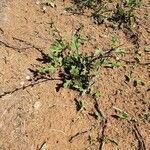A herb. It grows up to 60 cm high. It is a sprawling plant and the lower parts of the stems lie along the ground. The leaves taper at each end. The leaf stalk is expanded to form a tube around the stem. This often has soft bristles at the top. This tube is 0.5 cm long. The leaves can be simple or divided into rounded lobes. The flowers are on a long leafless stem. This can be 30 cm long. The fruit has a sharp point at the top and 3 sharp prickles near the middle.
Flowers pedicellate, 2–5 in the axil of each bract, arranged in spiciform terminal or axillary racemes up to 28–45 cm long, sometimes longer; bracts up to c. 6 mm apart, obliquely truncate, acute or acuminate with a fringe of setae at the apex; pedicels of hermaphrodite flowers stout and 4–5 mm long, pedicels of male flowers filiform and withering.
Nut 5–7 mm long, fusiform, trigonous, pubescent or papillose, rarely glabrous, usually erect or spreading, seldom pendulous, with 3 spreading prickles 1.5–2 mm long on the angles, centrally or sometimes just below the middle, rarely with 3 smaller prickles on the faces between the angles.
Leaves petiolate, lamina 4–8 × 1–3 cm, ovate to ovate-elliptic or ovate-lanceolate to elliptic-lanceolate in outline, usually deeply incised with 1–3 rounded or acute lobes on each side, often panduriform or lyrate, narrowed to each end, midrib prominent beneath; petioles 1–2 cm long.
Styles 2 mm long, connate at the base for c. 0.5 mm; stigmas of long-styled flowers reaching only to the tip of the anthers or to slightly beyond, stigmas of short-styled flowers reaching or nearly reaching the anther bases.
Annual herb, up to 0.6 m high. Leaves with broad lobes. Nut trigonous, conical at base and apex with sharp spreading spine from each angle below the middle, with 3 smaller prickles at centre of angles. Flowers white.
Hermaphrodite flowers slightly heterostylous; perianth white or pink, 4–5-lobed; tube 1–1.5 mm long; lobes 2.5–3(4) mm long and ovate-elliptic.
Stems green to reddish-brown, up to c. 1 m tall, branched, longitudinally striate, glabrous or pubescent.
Ocrea reddish, up to c. 5.5 mm long, truncate and fringed with setae at the apex.
Filaments 2 mm long in long-styled flowers, 1.5 mm long in short-styled flowers.
A diffuse, erect or decumbent annual herb.
Male flowers not seen.












